
vancouver royal canadians
Introduction Following the 1966 FIFA World Cup held England and broadcast in the United States, promoters came together to start up two professional soccer leagues in U.S - the United Soccer Association (sanctioned by FIFA and the United States Soccer Federation) and the National Professional Soccer League (not sanctioned).
With encouragement and sanctioning from the U. S. Soccer Federation and FIFA, the North American Soccer League (NASL) in 1967 announced plans to begin operating in 1968. Suddenly confronted by a competitor, the National Professional Soccer League (NPSL), the NASL changed its name to the United Soccer Association (USA) to avoid confusion with the other league and decided to play its first season in 1967. Due to a lack of time in recruiting their own players to teams the United Soccer Association imported full teams from other nations, placing them in U.S. and Canadian cities, thus forming outfits for a summer league (summer season represented the off season for European and South American leagues). In Europe the tournament was allegedly brokered by the TV commentator Kenneth Wolstenholme, former England forward Jimmy Greaves, ex-Nottingham Forest forward Roy Dwight (an uncle of Elton John) and London businessman Jim Graham. The National Professional Soccer League had a national television contract in the U.S. with the CBS television network, but ultimately the ratings for matches were unacceptable even by weekend daytime standards and the arrangement was terminated. Lamar Hunt But the league carried on, thanks to the perseverance of Lamar Hunt, the Texan who had been inspired by the 1966 World Cup final, one of the most dramatic games in football history. The final, between host England and West Germany, was televised in 52 nations and watched by 400 million people. Hunt was one of the Americans who saw its delayed broadcast in the United States. The importance of Hunt should not be underestimated and it is worth taking a closer look at the man who was a big power broker behind the tournament. Born in El Dorado, Arkansas in 1932, Lamar Hunt became one of the great innovators in American sports. Hunt was an original investor in what became the North American Soccer League (NASL) with the Columbus Crew and Kansas City Wizards, having owned the Dallas Tornado in 1967. A sports model franchise for 14 years, Hunt saw the league grow from five clubs to 24 in ten years. The NASL folded in 1985, but when Major League Soccer (MLS) formed in 1996, Hunt once again became a major player in an effort for the United States to take its place on soccer’s world stage. As a child Hunt was nicknamed “Game'' because of his passion for inventing new games and scoring systems. This passion continued as Hunt is credited with introducing the two-point post-touchdown conversion to the NFL. Lamar Hunt died December 13, 2006 in Dallas, Texas at the age of 74 after a long battle with cancer. However amongst his other achievements was the founding of the World Championship Tennis circuit in 1967, giving birth to the open era in tennis. He is also credited with coining the name "Super Bowl", inspired by a red, white and blue super ball owned by his daughter. Other Backers Among the rival NPSL's backers were Art Rooney, owner of the NFL's Pittsburgh Steelers, and Jerry Hoffberger, owner of baseball's Baltimore Orioles. It had 10 teams: the Atlanta Chiefs, Baltimore Bays, California Clippers, Chicago Spurs, Los Angles Toros, New York Generals, Philadelphia Spartans, Pittsburgh Phantoms, St. Louis Stars, and Toronto Falcons. Because the NPSL was not sanctioned by soccer's national and international governing bodies, as the USA was, its teams had problems finding players, since they faced possible suspension for playing in the league. Sunderland AFC as part of the USA became the Vancouver Royal Canadians; Brazil's Bangu Atlético Clube, amongst others, became the Houston Stars. Together they joined a further 10 original teams in the United Soccer Association. The other international teams were: Scottish clubs Dundee United (Dallas Tornado), Hibernian (Toronto City), Aberdeen (Washington Whips), English clubs Wolverhampton Wanderers (Los Angeles Wolves), Stoke City (Cleveland Stokers), Uruguay's Cerro Porteno (New York Skyliners), Holland's ADO Den Haag (San Francisco Golden Gate Gales), Northern Ireland's Glentoran of Belfast (Detroit Cougars), Italy's Cagliari (Chicago Mustangs) and Ireland's Shamrock Rovers (Boston Rovers). The 12-game season began in late May of 1967 and ran through to the mid July, with Los Angeles defeating the Washington Whips 6-5 in extra time in the first Championship game. In April, 1967, the 10-team National Professional Soccer League also kicked off with a 32-game schedule. The Oakland Clippers defeated the Baltimore Rays in a two-game championship series. In December of 1967, the two leagues (United Soccer Association and National Professional Soccer League) merged and 17 of the 22 teams remained to form the North American Soccer League (NASL) - which remained the top U.S. soccer league until 1984. The NASL would, of course, become synonymous with star footballers such as George Best, Franz Beckenbauer and the incomparable, legendary, Pele. Today it is know as the MLS (Major Soccer League) and of course, as I write, features the ultimate modern day footballer – England’s David Beckham._____________________________ Sunderland AFC In The United States & Canada Sunderland AFC’s affair with “Soccer” in the United States was due to start as far back as 1896, when it was mooted that they would become one of the first English teams to undertake an overseas tour. However the tour was cancelled at the last minute. Nevertheless our 1967 venture wasn’t our first taste of “Soccer” in the USA.
For the 1967 league, Sunderland were initially to have represented Washington DC. However basing clubs on the basis of where the organisers thought they would attract the biggest crowds, the red and whites were eventually sent to represent the City of Vancouver. Aberdeen, as The Washington Whips went to America’s capital. Sunderland received the contract to play in the United States in January 1967, and after careful consideration they were duly signed by the club’s Directors. One worry of course was that the English Football League season didn’t finish until 13 May and as the American version was due to kick off in late May, finishing in early to mid July, the close season for the players would be limited. There was also a further complication. There was a potential showdown with the Scottish FA who were undertaking their own summer goodwill tour of Israel, Malaysia, Hong Kong, Australia, New Zealand and Canada. Therefore it was of concern to the Americans that our big name players such as Jim Baxter and Neil Martin wouldn’t be able to line up in Vancouver. In the end they both went to Vancouver. Ian McColl, Sunderland’s Manager at the time stated that “We have received a letter from the Scottish Football Association regarding the availability of players for a close season tour. This tour however clashes with our trip to America and it is most unlikely that we would release players for Scotland” he said. In truth the club’s hands were probably tied by the Americans. Jimmy Montgomery didn’t travel with the initial party from Sunderland. He stayed behind to receive treatment on an injured back and also took part in an England Under-23 tour, as we shall see. However with results going against the red and whites he would soon join the team in North America. Some of the clubs such as Hibs and Stoke played in their traditional strips. Pictures of Sunderland show us in a first team strip of all red and a change of all white. Initially the organisers of the 1967 United Soccer Association League expected teams like Valencia, Real Zaragoza and Borussia Dortmund to accept invitations, but in the end they didn’t compete. As a substitute and to give the season a kick start, a series of exhibition matches were arranged for the weeks in the run up to the start of the tournament proper. Red Star Belgrade, Real Madrid, Liverpool, Leeds United, Vasas Budapest, West Ham, Eintracht Frankfurt, Rangers, Valencia and Benfica were some of the glamorous clubs invited to take part. At this stage, Wolverhampton Wanderers had not been included on the list of invited clubs. What the final outcome of the USA season would have been had they not taken part, can only be conjecture. In quick succession, the Football League in England refused permission to Leeds United and Liverpool to take part in the pre-season exhibition matches, although West Ham United travelled to Houston to take on Real Madrid. Their valiant efforts were in vain as they lost 3-2 before a crowd of 33,351 in the world’s first indoor match. The crowd was the second highest ever to watch a live game in the US. Among the other exhibition fixtures that took place, Valencia beat Rangers 1-0 in Toronto. The crowd was 21,940; Valencia scored after only four minutes and then defended for the remaining 86. The game was described as ‘rough and marred by fouls’. Finally, it should be noted that Sunderland, like the other competitors, were recruited as a Franchise team. The Directors of Sunderland AFC in effect had nothing to do with the league, the competition and carried no authority over it. Instead the teams were owned by American and Canadian businessmen who had paid the United Soccer Association a sizeable sum (mooted to be in the region of $250k) per team to operate in the league. _____________________________ MATCH 3
Sunderland Begin To Shine
Sunderland played particularly well on this their “home” debut and had four 18 year olds – Todd, Forster, Suggett and Hughes to thank for this. Billy Hughes made his appearance 20 minutes from the end and shaped up extremely well whilst the 80th minute appearance by debutant Heslop was also impressive. Baxter and Herd also gave virtuoso performances and it was the former, the midfield master, who kept Sunderland moving forward relentlessly. It was Herd, however, who laid on Sunderland’s first goal after 15 minutes, a deft touch allowing Neil Martin to put Sunderland ahead from 10 yards out. Sunderland’s defence then went to sleep and a series of appalling lapses should have seen The Red & Whites trail at the interval. “Fortunately” the only damage done was a 38th minute Bill Hainey equaliser for the visitors. The inside left ran onto a lovely long range ball from Mogens Berg, out muscled Todd and drove the ball home. In the second half it took Sunderland just 60 seconds to effectively seal the game when a smashing move involving inside right O’Hare and Colin Suggett resulted in the latter, superb on the tour so far, netting from close range. Mulhall scored with a crashing header after 74 minutes from a cross by Billy Hughes but kept the best for last, a 35 yard pile driver 6 minutes from time. Sunderland left the field to delighted applause from “their” fans and well deserved it was too. Vancouver Royal Canadians: Forster, Irwin, Parke, Todd, Kinnell, Baxter, Suggett, O'Hare, Martin, Herd, Mulhall, Subs – Hughes, Heslop _____________________________ United Soccer Association 1967
_____________________________ Vancouver Royal Canadians
_____________________________ The 1967 Legacy Sunderland’s party of 20 players and officials flew back into Newcastle Airport on the afternoon of 11 July 1967 via London and a 6 hour wait in Amsterdam having missed their connection. We wouldn't return for an encore in 1968.
“The crowds were a bit disappointing, though the fans that did come were ok and seemed very appreciative of what was going on. It was interesting too see how a home crowd supported a home team, even though it was adopted. Most of the grounds were alright. I’ve got one criticism – they let the grass grow terribly long”. He added. “The boys are a bit tired now. It was a longish trip and the games were a bit hard. It was a wonderful experience for the younger players and I’m very satisfied with their progress. I think this will help American Soccer a lot, though they’ll need to promote it hard”. His final comments were that “We’ve no regrets about going. We could have been back in 12 hours at anytime if anything had come up. I intended to see it through but I don’t think I would consider it again”. The USA merged with the National Professional Soccer League to form the North American Soccer League. For the 1968 season the Vancouver Royals did get together again, but this time were represented by players from around the globe, including 6 Englishmen. Coached by Ferenc Puskas, the famous Hungarian they played 32 matches, ending bottom of the Pacific Division. They would go out of existence and reform as the Vancouver Whitecaps in 1974, until their eventual demise in 1984. For those insisting that it was Bobby Robson who managed Vancouver in 1968, you stand corrected. A curious situation arose when Golden Gate the San Francisco franchise folded and merged with Vancouver. With Bobby Robson having signed for Vancouver on 10 May 1967 and Puskas for San Francisco something had to give. It did. Robson was offered the Assistant Manager post, declined and the Magical Magyar was left in sole charge. Colin Todd would return to play in Vancouver for the Whitecaps taking part in their farewell season, alongside another ex Roker favourite, Tony Towers. By this time they were playing their games at the BC Place Stadium in Vancouver. Another famous ex player is Peter Beardsley, and Sunderland goalkeeper Barry Siddall, spent a summer with the Whitecaps in the early 80s. Match day programmes for the 1967 United Soccer Association season do exist and can command prices of up to £150 – particularly those involving Sunderland AFC.
|
||||||||||||||||||||||||||||||||||||||||||||||||||||||||||||||||||||||||||||||||||||||||||||||||||||||||||||||||||||||||||||||||||||||||||||||||||||||||||||||||||||||||||||||||||||||||||||||||||||||||||||||||||||
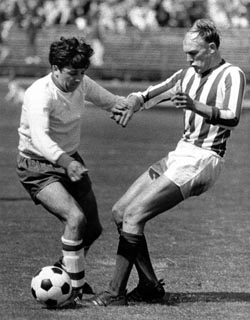 The reason for the formation was clear; the World Cup had been won, for the first time, by an English speaking nation and television audiences for the competition had been high in the USA. The game was further promoted in the USA by the documentary film ”Goal!” which was the official FIFA film of the 1966 tournament. Never short of entrepreneurs, various business men, particularly stadium owners, saw the potential for a re-birth of the sport in their country.
The reason for the formation was clear; the World Cup had been won, for the first time, by an English speaking nation and television audiences for the competition had been high in the USA. The game was further promoted in the USA by the documentary film ”Goal!” which was the official FIFA film of the 1966 tournament. Never short of entrepreneurs, various business men, particularly stadium owners, saw the potential for a re-birth of the sport in their country. 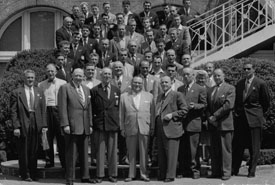 In 1955 the club toured North America playing at Ebbets Field, the famous home of The Brooklyn Dodgers Baseball team against an American Soccer League XI and other venues such as Downing Stadium on New York’s Randall Island against Huddersfield Town. All in all they played 9 games; 4 against the aforementioned Yorkshire team.
In 1955 the club toured North America playing at Ebbets Field, the famous home of The Brooklyn Dodgers Baseball team against an American Soccer League XI and other venues such as Downing Stadium on New York’s Randall Island against Huddersfield Town. All in all they played 9 games; 4 against the aforementioned Yorkshire team. 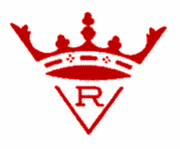
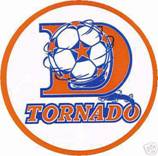
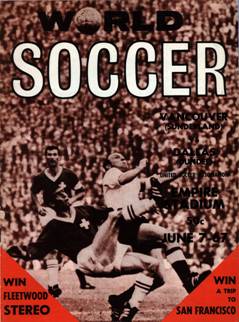 Brian Heslop, Sunderland’s £3,000 signing from Carlisle United was expected to make his debut in this game, however in the end he had to settle for a place on the subs bench. Manager McColl had hinted that he would play left back but an 11th hour change of heart saw Sunderland keep the same back 4.
Brian Heslop, Sunderland’s £3,000 signing from Carlisle United was expected to make his debut in this game, however in the end he had to settle for a place on the subs bench. Manager McColl had hinted that he would play left back but an 11th hour change of heart saw Sunderland keep the same back 4. 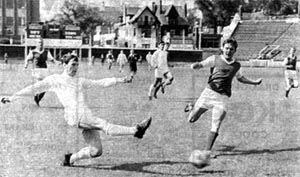 “It was a good experience, but we won’t be going back again” was Sunderland Manager Ian McColl’s pronouncement. He put the cause of Sunderland’s below par performances down to the fact that they failed to acclimatize. “We had so many young players who’d never travelled before” he said. He went on. “It was a tough tournament. There was a lot of travelling out there and it was very hot”.
“It was a good experience, but we won’t be going back again” was Sunderland Manager Ian McColl’s pronouncement. He put the cause of Sunderland’s below par performances down to the fact that they failed to acclimatize. “We had so many young players who’d never travelled before” he said. He went on. “It was a tough tournament. There was a lot of travelling out there and it was very hot”.